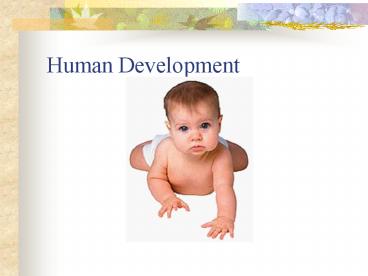Human Development - PowerPoint PPT Presentation
1 / 45
Title:
Human Development
Description:
Stages of Physical Development. Neonate - 'newborn' Infancy. Toddlerhood. Childhood ... Psychiatrist who studied death and dying. End-of-Life Decisions ... – PowerPoint PPT presentation
Number of Views:3870
Avg rating:5.0/5.0
Title: Human Development
1
Human Development
2
Perspectives on Development
- Physical Development
- Intellectual Development
- Cognitive Development
- Moral Development
- Social and Personal Development
3
Fetal Alcohol Syndrome
smaller headsdeformed facial featuresabnormal
joints and limbspoor coordinationproblems
with learningshort memories
4
Teratogens Monster Makers
- Alcohol, recreational drugs, prescription
medicines, viruses, bacteria, toxins, etc. - Any of the above can be teratogens and disrupt
normal fetal development
5
Germinal Period (2 weeks post-conception)
- Fertilization
6
Germinal Period
- 2 weeks
7
Embryonic Period (six weeks after Germinal Period
- 4 weeks after conception
8
Embryonic Period
- 5 weeks after conception
9
Embryonic Period
- 8 weeks
10
Fetal Development
- 18 weeks
11
Fetal Development
- 20 weeks
12
Fetal Development
- 24 weeks
13
Fetal Development
- 30 weeks
14
Fetal Development
- 40 weeks
15
Stages of Physical Development
- Neonate - newborn
- Infancy
- Toddlerhood
- Childhood
- Adolescence puberty
- Adulthood
- Middle Age
- Advanced Age
16
Motor Development
- Motor Development proceeds in a down and out
fashion. - Head and arm control comes before leg and foot
control. - Control also begins in the center of body then to
extremities - Large muscle control precedes control of small
muscles
17
Stages of Motor Development
- Sits without support 5-6 months
- Pulls to standing position 7-8 months
- Crawls 10
months - Stands alone 11 12 months
- Walks alone 12 months
- Sequence of steps is fixed the ages at which
they occur are not fixed.
18
Toddlerhood to Adolescence
- During this period, physical growth continues,
but at a slower rate than before. Eye-hand
coordination improves dramatically. - During adolescence, a growth spurt occurs.
Physical growth and development increases
rapidly. - Puberty is the time when a person reaches sexual
maturity. Around age 11 for girls and age 13 for
boys. - Hormones of the endocrine system cause the onset
of puberty
19
Sexual Maturity
- Estrogens in females and androgens in boys
(hormones) lead to the development of secondary
sex characteristics. - Girls develop breasts, hips broaden
- Menarche is the onset of menstruation (age 12-13)
- Boys develop facial hair, voice deepens, ability
to produce semen. - Onset of menarche was at about age 16 in 1880.
This demonstrates the impact of environment
(better diet, living conditions) on a genetically
programmed event.
20
Adulthood
- Not the same thing as sexual maturity
- Some cultures have rituals that mark the
transition to adulthood - Acceptance of socially defined responsibilities
of adulthood.
21
Aging
- Decline of physical strength, agility, other
signs of aging begin in mid-twenties. - Menopause (around age 50 in women) is the
cessation of ovulation end of menstrual period. - No comparable period for men.
22
Aging and the Brain
- Brain cells are lost with age
- Neurons that remain take up the slack by
increasing complexity. - Alzheimers disease about 1 of people 65 years
of age and about 20 of 80 year olds.
23
Moral Development
- How do we make moral decisions?
24
Stages of Moral Development
25
Jean Piaget and Cognitive Development
- Swiss Psychologist (1896-1980)
26
Piaget Some Concepts
- Schemata Mental models of the world the way
we all organize the world in a meaningful way.
Based on experience with the world. - Assimilation fitting new information into
existing schemata. - Accommodation changing or modifying existing
schemata to accommodate new experiences when they
occur.
27
Stages of Cognitive Development
28
Object Permanence
- Object Permanence Objects continue to exist even
though they are out of sight.
29
Has this ever followed you home?
30
Conservation
- Conservation the ability to recognize that the
physical properties of an object remain the same,
despite changes in physical appearance.
31
Conservation of Volume
32
Social and Personality Development
- What is the role of early attachments, strong
emotional bonds to another person, on social
development?
33
Harry Harlows Studies
- Monkeys fed only by the wire-mesh mother.
- Wanted to know if monkeys would become attached
to the mother who provided food. - Most monkeys preferred the cloth mother, though
they were never fed by her. - Contact Comfort was determined to be the primary
motivator of attachment.
34
Attachment in Humans
- Developmental problems more likely among children
raised in poorly staffed orphanages.
35
Types of Attachment
- Strange Situation Test How does infant respond
to parent in a stressful situation? - Secure Attachment O.K. as long as mom is
present. Uneasy clingy if stress increases.
About 70 of infants in this group. Cries when
mom leaves room, but calms down when she returns.
36
Attachment
- About 10 of infants will show resistant
attachment. Reaction to stress is ambiguous. Do
they trust the parent? Do not leave mothers
side in strange setting. Cry if mom leaves the
room. Do not return to her when she comes back,
but act angry or resentful. - Avoidant Attachment describes the remaining 20.
These kids arent bothered by the strange
situation test. They show no reaction when
mother leaves room or when she returns. Parent
typically unresponsive and impatient with child.
37
Personality and Identity
- Erik Erikson (1902-1994) pictured with his wife,
Joan.
38
Eriksons Stages of Personality Development
39
Gender Role Development
- Foundation for gender identity evident around
ages 2-3. - By elementary school, gender identity is firmly
entrenched. I am a boy and always will be. - Gender roles specific ways that expects boys and
girls to behave and roles they should assume. - Nature or nurture?
- Social Learning Theory predicts that gender roles
are the result of modeling behavior of others and
rewards for acting in gender-appropriate ways. - The work of John Money and sex reassignment
surgery
40
Growing Old
- Some types of intelligence increase with age, as
does confidence to do tasks - Health care costs a major concern. Costs may
outpace coverage. - Expect increase in people living to gt85
41
Ageism
- Prejudice against an individual based on physical
age. - Negative stereotypes about the elderly (lonely,
isolated, in mental decline, feeble) fuel
negative consequences - Most negative stereotypes about older people do
not hold true for the majority of the elderly.
42
Elisabeth Kubler-Ross
- Psychiatrist who studied death and dying
43
(No Transcript)
44
End-of-Life Decisions
- Survey by Cicirelli (1997) of people aged 60-100
found - Given a terminal illness, the majority would take
steps to preserve life - Religious convictions and fear of death important
factors
45
The End (of this lecture)































